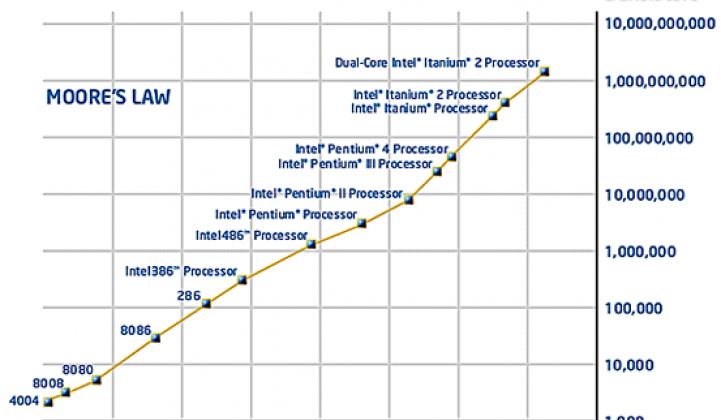Varian Semiconductor, headquartered in Gloucester, Massachusetts, believes it can bring a Moore's Law-like momentum to solar.
Moore's Law is the observation made by Intel co-founder Gordon Moore in 1966 that the number of transistors that can be placed on a chip can be doubled every 24 months.
But Moore's Law doesn't really map to solar. Moore's Law is about getting small. With solar, shrinkage doesn't work. Shrinking a solar cell reduces the surface area that is exposed to the sun, which reduces the amount of power it can generate. In the solar space, at least, smaller is the enemy of better.
"This is not the chip industry. The rate of change is completely different," said Joseph Laia, CEO of MiaSolé. "I don't have Moore's Law. [...] I don't have shrink."
Photovoltaics do seem to be based on a relationship between volume production and cost. It's said that for every doubling in solar volume, there is a twenty percent reduction in cost. But Rubin's Conundrum posits that the relationship is observed but not causal. The cost reduction is not due to volume but to other factors -- usually technology advancements required to become or stay competitive. It is those “other factors” that Varian hopes to address, by giving solar cell engineers new options for cell development and production.
Ion Implantation to the Rescue
Varian supplies ion implantation equipment to most of the major semiconductor manufacturers in the United States, Europe and Asia. Revenue in the firm's most recent quarter was $227.7 million.
According to Jim Mullin, the Vice President and General Manager of Varian's solar group, 90 percent of crystalline silicon cells are the same product made on the same equipment. Varian is looking at a way to fundamentally change the c-Si cell itself.
Mullin suggests that the silicon solar cell "is essentiality just a diode" with a semiconductor junction. And the quality of that junction determines the quality of the cell.
Twenty-five years ago, most semiconductor junctions were made with a diffusion process. But ion implantation provides a higher quality junction and because of that, the semiconductor industry transitioned to ion implantation long ago. It's part of what has enabled Moore's Law to flourish and has "almost wholesale replaced diffusion furnaces" in semiconductor manufacturing today.
According to Mullin, solar cell production is not complex -- it's basically a six-step process. The current diffusion process is a "blanket process" and the dopant for p-type cells, phosphorous, diffuses into both sides of the cell, although it's only needed on one side. The solar industry either has to mask one side or remove the dopant on the other side.
Contrast this to the one-sided implant process.
Diffusion is also a high-temperature process which creates a glass layer that has to be removed after the process is complete. Implantation is not a high-temperature process, so there's no need to remove glass.
Paul Sullivan, Varian's Vice President of Business Development, said, "We can remove two of the six steps and at the same time improve the efficiency of the cell." Sullivan also claimed that eliminating some of the steps reduces handling requirements, which in turn improves yield and throughput. "We're saying, get rid of the diffusion process, get rid of wet bench glass removal and get rid of the edge isolation step."
Junction quality depends on dopant uniformity. In the diffusion process, uniformity of the junction is three to ten times looser than the uniformity of the implant process, according to Varian. This means that the binning distribution in implant-process solar cells is much tighter. Sullivan claimed that this could translate to $3 million more revenue on a $100 million production line.
So ion implantation has the potential for higher efficiency, lower cost and improved throughput.
Advanced Semiconductor Processes
Today, Varian can do blanket emitters with implanted phosphorous as well as patterned phosphorous emitters. Future roadmap products include boron implantation and patterned boron with potential cell efficiencies approaching 23 percent.
The selective emitter design uses a lightly doped emitter without trading off with contact resistance. Implantation is done through a mask to create a heavily doped region below the "fingers" to enable selective emitter structures.
The solar team is spending a lot of time in China and sees itself competing with Suntech's Pluto process and other technologies going after higher efficiency crystalline silicon. The firm shipped its first solar production tool a few weeks ago after shipping many R&D tools to production sites around the world.
Varian has shipped thousands of semiconductor tools that are currently in the field running 365 days per year. The team I spoke with prided itself on understanding ramp-up and production. Sullivan said, "Scaling is the thing we do well."
The company envisions 18-month, semiconductor-type process improvement cycles finally reaching solar and bringing at least a hint of Moore's law to this industry.
***
Michael Kanellos contributed to this article.



